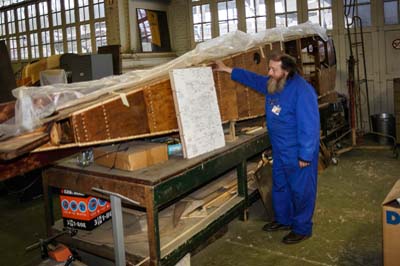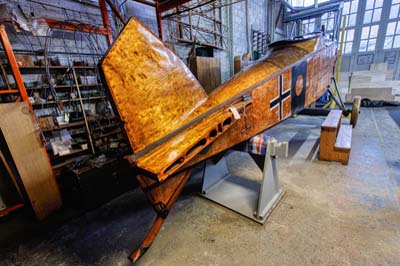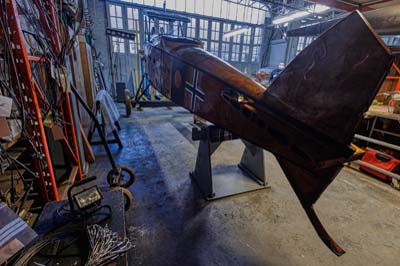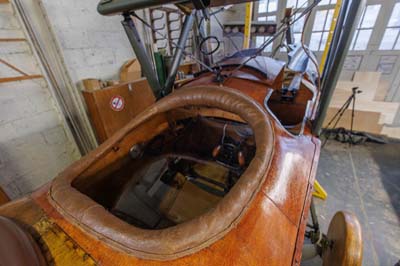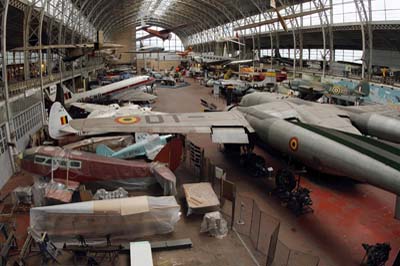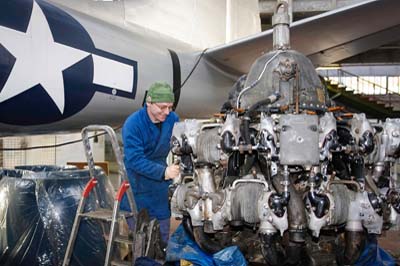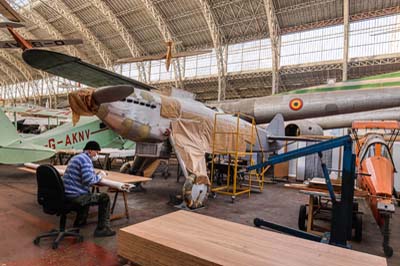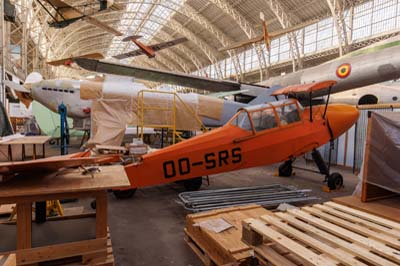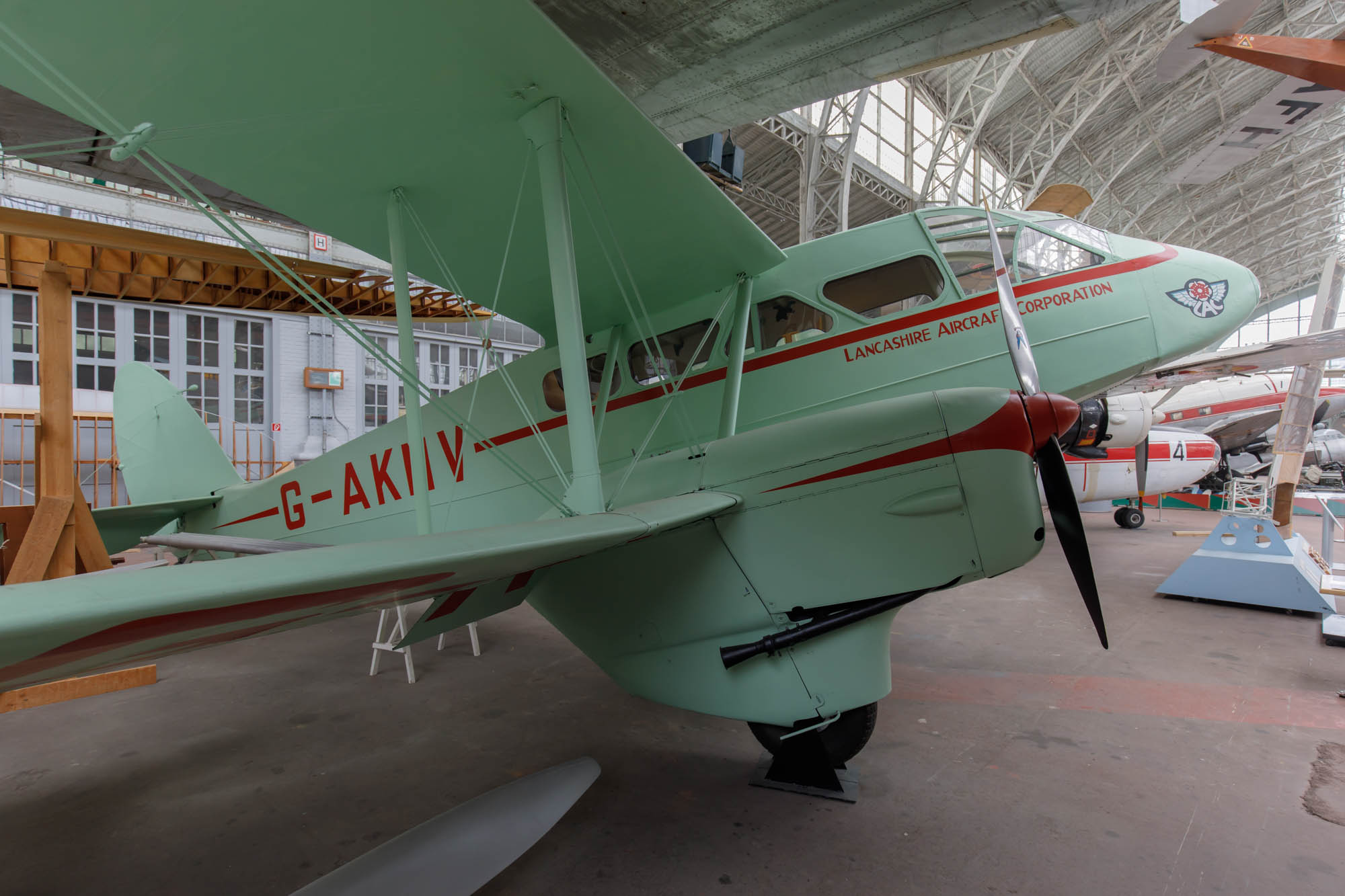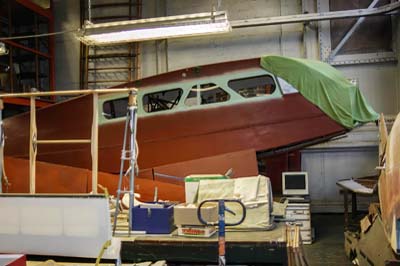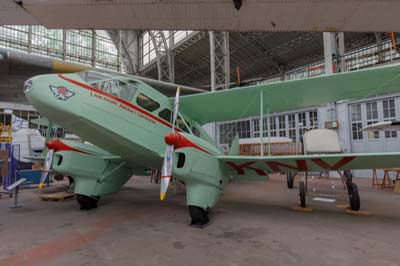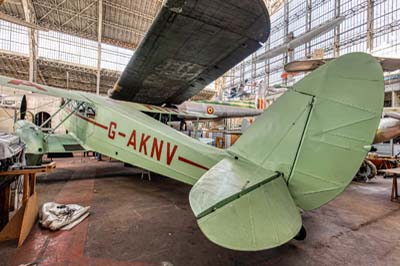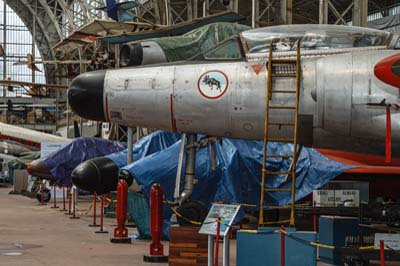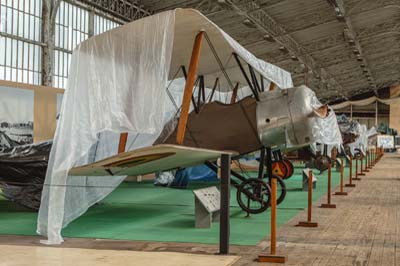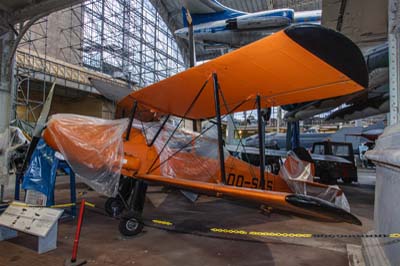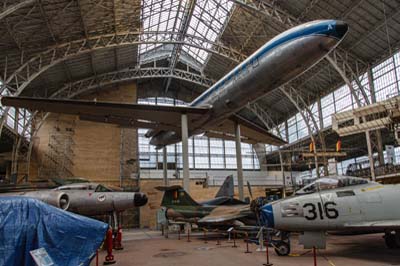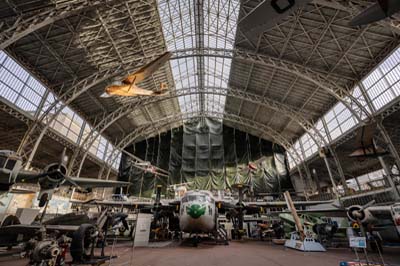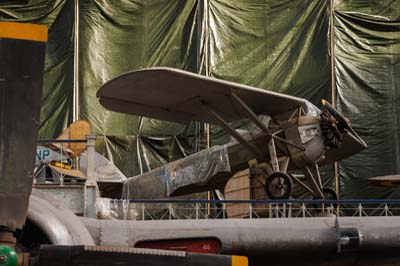Royal Museum of the Armed Forces and of Military History
(Air and Space Department)
(Musée Royal de l'Armée et d'Histoire Militaire, Bruxelles)
Brussels
2005, 2009, 2018, 2019, 2022 and 2024 |
Aircraft restoration - A work in progress
What I particularly like about the Museum is that it is a working museum. Volunteers perform painstaking restoration in workshops at the far end of the hall and also within the main exhibition area. Restoration is formally carried out by two groups; the Brussels Air Museum Fund (BAMF) and the Brussels Air Museum Restoration Society (BAMRS). Funded by donations they are always looking for volunteers. Visitors are often able to see and talk to the dedicated enthusiasts while they are at work.
In 2005 major work was being carried on the A-26B Invader (44-34765) in the main hall and on a DH.89 Dragon Rapide (OO-CNP) and Imperial German Flying Corps Luft-Verkehrs-Gesellschaft LVG C.VI (5141/18) in the workshops. Numerous other disassembled airframes and equipment are stored adjacent to the workshops, awaiting some loving care and attention. |
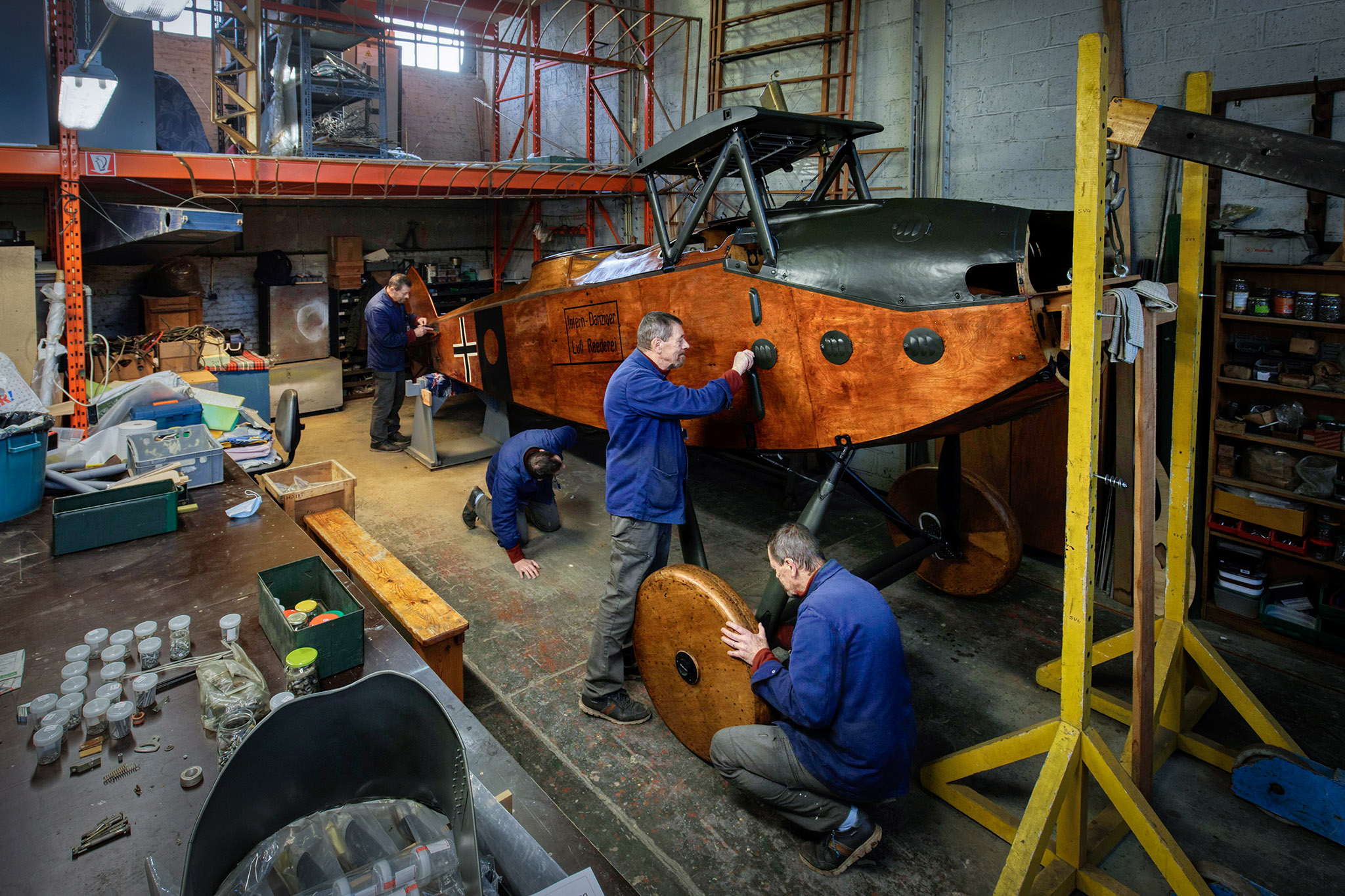 |
| British volunteer aircraft restorer Michael Lewis hard at work checking the Luft-Verkehrs-Gesellschaft LVG C.VI. |
Restoring the Luft-Verkehrs-Gesellschaft LVG C.VI
In February 2022 I had the pleasure of enjoying a coffee in the museum's restaurant with Jean-Paul de Caluwé, President of Brussels Air Museum Restoration Society (BAMRS) and Michael Lewis, a British volunteer aircraft restorer who has been living in Belgium for 20 years. BAMRS is a subsidiary of the AELR (Air Espace Lucht Ruimtevaart) a non- profit organisation responsible for the restoration of aircraft and historical documentation of Belgian aviation heritage both military and civil starting from the earliest days of flight up until the present day.
Acutely short of funds the never-ending challenge of restoring historic aircraft is foremost priority for Jean-Paul de Caluwé. The entrance fee to the museum and monthly book fare fees are all used for the upkeep of the building. A remarkable historic building which is in a very sad state with a leaking roof and a crumbling structure. However, the BAMRS can keep any profit they make from the restaurant, so if you are visiting break up your day, and it will take up a day, with at least a coffee.
Mike Lewis is an interesting character he spends 20 hours a month in the restoration workshops adjacent to the main hall. I asked what motivated him to spend so much time there, "I like using my hands, I am very interested in World War One aviation. When you sit in these old aircraft I can't believe how men flew these flying machines and did battle."
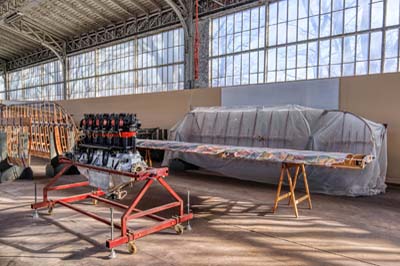 |
The restored Benz Bz.IV 6-cylinder water-cooled in-line piston engine with the wings for the LVG C.VI are currently stored on the mezzanine. |
One of the ongoing restorations by a team of five is their Luft-Verkehrs-Gesellschaft LVG C.VI, a German two-seat reconnaissance and artillery spotting aircraft flown during World War One. Mike spent seven years restoring the Benz engine, initially carefully dismantling it to understand how it worked, whilst making sure it could be put back together.
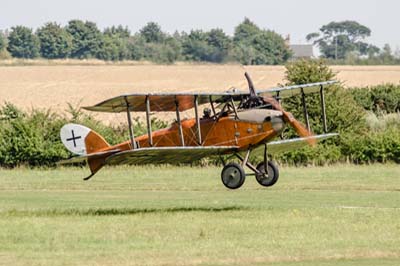 |
LVG C.VI (7198/18 registered G-AANJ). Following its final flight in 2003 it was transferred to the RAF Museum at Cosford for restoration involving repairs to the wooden airframe structure. Application of a new fabric covering to flying surfaces was completed in March 2016. It was discovered at this time that parts from two or three different aircraft had been utilised indicating cannibalisation to produce a serviceable machine. |
Fortunately, it was not difficult to find an original manual for the engine as the Benz engine was used in many World War One German aircraft. An endoscope was used to look inside it to check that the pistons were not seized to reduce risk of damage during deconstruction. The dismantling of the engine was carefully documented to learn how it all works and so it could be put back together easily. It had to be cleaned and missing parts had to be found. Some parts were manufactured onsite using their lathe. Some missing parts were found on the Internet. "It is full of people selling original or purporting to sell original parts. You wonder where they came from, particularly an aircraft like this where there are only three are left in the world."
One LVG C.VI (7198/18 registered G-AANJ) is being restored by the RAF Museum at Cosford since 2003 when it made its last flight with the Shuttleworth Trust at Old Warden. The third unrestored example (9041/18) is with the Musée de l'Air et de l'Espace (Ailes Anciennes - Ile de France) at Le Bourget-Dugny, Paris but not on public display.
The BAMRS has worked with the other two LVG C.VI custodians sharing advice and swapping parts. A replica LVG C.VI was built by the Memorial Flight Association based at La Ferté-Alais, for The Vintage Aviator Limited (TVAL) at Hood Aerodrome, Masterton in New Zealand. The BAMRS were missing two distributors, "It was impossible to find the exact ones but Sir Peter Jackson's [Oscar winning film director and producer] team in New Zealand said they could manufacture some false [replica] ones to the exact pattern we have" spoke Mike Lewis explaining that, "As it is not going to fly again they did the job, they look like the originals." Typical of aircraft of its day the LVG C.VI was hand crafted. "The amazing thing is that the life expectancy of these aircraft was very short, but when you look at the workmanship its builders had pride in what they were making." spoke Mike Lewis. Eighty percent of their aircraft is original and now following restoration it looks immaculate; "This is due to the skill of the restorers, when you see these aircraft before any restoration, they are often in a pitiful state following years of storage sometime outside." said Mike Lewis. They try to conserve as much of the original as possible, "some of the parts are so rotten, almost powder riddled with woodworm." He said.
The fabric flying surfaces are still to be applied to the wings and tail section. A company in France is the only manufacturer able to make the five-colour lozenge fabric, they made an exact copy using original fragments they gave to them. They now have the expensive one-off run fabric at the museum.
The logbook continues to be kept of the hours spent restoring this rare aircraft which will be completed more than 20 years after it was started in 2000. |
Luft-Verkehrs-Gesellschaft LVG C.VI (5141/18 note several serial numbers were found during restoration). A reconaissance aircraft of the Die Fliegertruppen des deutschen Kaiserreiches (Imperial German Flying Corps) in October 1918, it was used by the Belgian Aéronautique Militaire after the war. In the years following the World War One a number of these aircraft moved from Germany to the Belgian civil register and also on to the Belgian Air Force.
This example is one of only three examples of an LVG C.VI that exist. It was rebuilt utilising canabalised LVGs also held at the Evere. By 1925 it was with the museum hanging from roof in the World War One hall. In 1970 it was moved to the mezzanine when the Musée Royal de l'Armée et d'Histoire Militaire was formed.
Left to right: In 2005 it was five years into its long-term restoration. By 2022 restoration was still underway. |
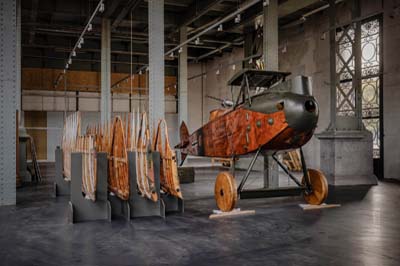 |
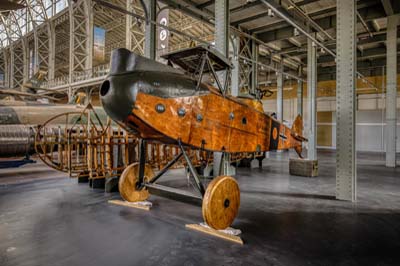 |
| Luft-Verkehrs-Gesellschaft LVG C.VI (5141/18) in October 2024. At some point the wings will have the new fabric applied by staff at Musée de l'Air et de l'Espace, Le Bourget, Dugny, Paris. |
Left to right:
The aircraft hall in 2009 showing the south side restoration area with some of the current restoration projects in the foreground.
Douglas A-26B Invader (N67160 ex D-CAFY and marked 44-34765 'AN-J') Pratt and Whitney R2800-70 Double Wasp engine being cleaned up by another of the many volunteers in 2005.
Renard R.31 (Replica). A single engine two seat observation aircraft from the 1930s built for the Belgian Air Force.
Stampe SV-4D (OO-SRS c/n 1208). More images and details below. |
| DH.89A Dragon Rapide (OO-CNP ex OO-AFG and G-AKNV) under restoration in 2005. |
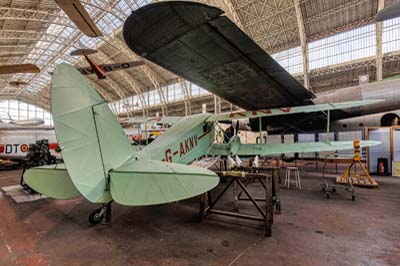 |
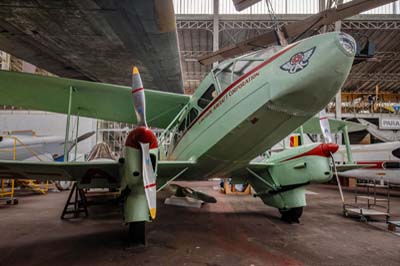 |
DH.89A Dragon Rapide (OO-CNP ex OO-AFG and G-AKNV) under restoration in 2005. In 2024 it is still to be found in the restoration area.
Built for the RAF in 1939 as a Dominie (R5922) with whom it served until 1947 before being sold as G-AKNV. By 1955 it had been bought by Fairy Aviation and transferred to Avions Fairey at Gosselies in Belgium as OO-AFG and later Air Affaires, before becoming OO-CNP in 1964. It was cancelled from the register in 1970 after an emergency landing and was given to the museum in 1973 following many years in open storage at Wevelgem. The restoration was properly started in 1993, by 2001 the cabin's refurbishment was complete. It was intended to present the aircraft in it's Lancashire Aircraft Corporation colours of 1947.
The Dominie was built by de Havilland as a military version of the DH.89 Dragon Rapide. The DH.89 was first flown in 1934 and by the time production ended about 10 years later, 728 had been built over 530 Dominies served with the Royal Air Force.
The Belgian Air Force received seven ex RAF DH.89 Dominies in 1946 for 367 Squadron (Smaldeel/Escadrille) later renumbered 21 Squadron (serials D-1 to D-7).
|
Great Hall restoration
Following discussions between the Museum owners (Régie des Bâtiments / Regie der Gebouwen) and the Museum administrators (KLM / MRA) a request for tender in June 2006 was issued for the refurbishement of the Great Hall. It was speculated with the extent of the restoration required on the building, that the museum may have to close for an extended period possibly years. In reality repairs were started without closure of the Aviation Hall. In December 2009 the south side frontage was covered with scaffolding erected. Most of the aircraft at that end of the hall were covered in plastic to protect them from the leaking roof and falling debris. The upper tier was also closed to the public. |
| In December 2009 repairs to the south glass and iron work along with a new tin roof on the east side, was well underway with extensive scaffolding in place. Many of the aircraft were covered in plastic sheets to protect them from the water leaking through the roof. |
| By October 2024 most of the glass had been replaced, only the glass at the northern end and hidden by a tarpaulin was unfinished. There is still extensive scaffolding outside and all the aircraft on the mezzanine are under plastic sheeting including the Morane-Saulnier MS.315. |
Aircraft in Storage
Inheriting many of its aircraft from the Belgian Air Force, as they become withdrawn, has meant that over the years the Museum has needed to store aircraft away from main exhibition halls. At the end of the 1970s they were using a store at Tongerlo for numerous F-84s and other surplus aircraft. Tielen was also used at this time for the Museum's Austers, Stampes and Super Cubs. Later the air base at Koksijde was used for storage along with Saffraanberg which was used for the Bolingbroke restoration. Later still, the majority of stored aircraft were moved to a store at Kapellen. The Museum then had a new and sole storage facility at Vissenaken, located between Brustem and Bevekom/Beauvechain. From 2010 aircraft previously stored at Kapellen which were moved to Vissenaken were then moved on to Landen. |

